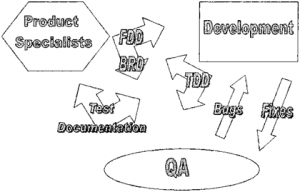The tester has responsibility to verify that the software does exactly what it should, and the way it is supposed to. The situation, when the user clicks the Print button, and instead of being sent to printer the document is simply saved, is inadmissible for a well-tested product. QA testing companies thoroughly check the apps and improve them to avoid the problems of the kind. Quality Engineer is the same tester, but only responsible for the quality of the product throughout the development cycle. Let us look at the typical scheme of such a cycle.

As can be seen from the scheme, the business requirements development department (BRDD) (Product Specialists) provides a testing group (QA) and a programming team (Development) with the two documents: BRD (Business Requirement Document), describing the business logic of the product created, and FDD (Functional Design Document), describing the functional requirements for manufactured products. Once programmers examine this documentation, they will create another document –TDD (Technical Design Document), which will then be sent to the business requirements development department and the testing group. After its consideration and approval by the business requirements department development, the testing group starts to write the test plan, test scenarios and test cases, which serve as a basis for further testing of the product. Meanwhile, programmers write source code. When the code is relatively stable, it is analyzed by the testing group. The tests help to find defects, and the programmers fix them, and the things proceed in this train until the product becomes sufficiently stable or time begins to press. This is, in fact, the entire cycle of the sectional development. Mobile testing services allow people to deliver great digital experience and delight mobile app users.
The responsibility of Quality Engineer starts with BRD and FDD reading. His responsibilities also include not only testing of the code, and not actually its testing but verification of the quality of all the components (and in particular the documentation) of given software to make sure that a desirable quality level has been reached. That is, if BRDD writes something obviously impracticable or not user-friendly, a quality engineer must sound the alarm. He is responsible for TDD consideration – if he knows that the user will need to have multiple windows open, each of which must regularly read / record database, he must strongly advise the person not to use such time-consuming things like Java Applets and JDBC in one.
Need to adapt software to foreign market?? This goal is almost unachievable with localization testing services.
Comments are closed.









